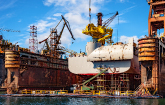Maritime Engines: Global Markets and Technologies to 2024
NEW YORK, June 25, 2019 /PRNewswire/ --
Report Scope:
This study reviews key marine and maritime engine technology categories, along with relevant market and production information, technological descriptions and issues, and key applications and market factors in major worldwide markets. This report organizes marine and maritime engine technologies into the following segments; detailed market data are presented for each of the following categories -
Read the full report: https://www.reportlinker.com/p05786771/?utm_source=PRN
Reciprocating Engines -
-
<1,000 kW.>- 1,000 to 3,000 kW.
- 3,000 to 10,000 kW.
- 10,000 to 18,000 kW.
- 18,000 to 25,000 kW.
- >25,000 kW.
Turbine Engines -
-
<5,000 kW.>- 5,000 to 10,000 kW.
- 10,000 to 20,000 kW.
- >20,000 kW.
The following marine and maritime applications are also considered within the global market for marine and maritime engines -
- Oil tankers (and oil product carriers).
- Dry bulk carriers.
- Container vessels.
- General cargo vessels.
- Gas carriers, including LNG.
- Chemical tankers.
- Ro-Ro vessels and ferries.
- Offshore vessels.
- Passenger and recreational vessels (including cruise ships).
- Military and patrol vessels.
Report Includes:
- 87 data tables and 55 additional tables
- An overview of the global market for marine and maritime engines
- Analyses of global market trends, with data from 2018, estimates for 2019 and projections of CAGRs through 2024
- Country specific data and analysis for USA, Canada, Netherlands, UK, Germany, France, China, India, Japan and South Korea
- Detailed description of reciprocating engines and turbine engines
- Coverage of recent advancements in the marine engine equipment industry
- Information on specific equipment categories with breakdowns by engine size, along with detailed information on specific applications within the segment
- Company profiles of major players in the market, including ABB, Cummins Inc., GM PowerTrain, Hyundai Heavy Industries, Mitsui E&S Machinery, Perkins, Rolls-Royce and Siemens
Summary
The global market for marine and maritime engines—founded in global markets for marine vessel construction and upgrade—is undergoing a period of considerable change and even turmoil.As recently as 2016, certain segments in the industry endured a near collapse as the market fell, for some categories, by as much as REDACTED in a single year.
As of 2018, many industry insiders had regained hope and in many cases profitability. Nonetheless, continued threats of looming volatility struck again in early 2019. What does the future hold and where are markets headed?
The markets for marine and maritime engines are influenced by a wide array of global, regional, and national geopolitical drivers, overlaid with macroeconomic trends and industry specific market forces.For example, changing global trade priorities have the potential to disrupt, substantially alter, or significantly benefit major segments of global trade, which will in turn directly influence demand for new ships and their components.
Adding complexity, the global maritime industry supports a wide array of individual industries ranging from recreation to mining and mineral extraction to consumer goods. At present, specific market segments are increasing strongly while others are declining, causing associated changes in demand for shipping, altering shipping costs, and driving shifts in global demand for new ships and the engines that power them. Other critical factors considered include, but are not limited to -
- New and forthcoming MARPOL emissions regulations, currently scheduled to come into force in 2020, which could influence demand for new ships, replacement engines, cleaner fuels, scrubbers, or a combination of these elements;
- Engine technology developments, which are driving increased efficiency;
- Increased competition from turbine engines, which could benefit from an increasingly stringent regulatory environment;
- Continued creep toward ever larger cargo ships, tankers, and cruise ships;
- Changes in focus regarding military ship applications;
- Volatile energy prices and significant changes in regional and national level energy demand;
- Incorporation of renewables and other advanced technologies;
- And various other trends and market factors, including those that are specific to the 10 shipping application categories considered in this study.
The key objectives of this report are to provide accurate market evaluations for marine and maritime engines; disclose reasonable and realistic market projections based on founded and comprehensive trends analysis; summarize key industry players as well as industry trends and product trends; provide an overview of relevant technologies; and most importantly, help you and your team to identify market hot spots, cold spots, points of entry, tappable niches, and pitfalls to avoid.
As shown in the table and figure below, the global markets for marine and maritime engines reached REDACTED in 2018, and are expected to grow from REDACTED in 2019 to REDACTED in 2024, for a compound annual growth rate (CAGR) of REDACTED. Interestingly, it is specialty, military, and recreational vessel applications that will comprise the largest segment of the market (including Ro-Ro vessels and ferries, offshore vessels, passenger and recreational vessels (including cruise ships), and military and patrol vessels), expected to reach REDACTED in 2024, with a CAGR of REDACTED.
Read the full report: https://www.reportlinker.com/p05786771/?utm_source=PRN
About Reportlinker
ReportLinker is an award-winning market research solution. Reportlinker finds and organizes the latest industry data so you get all the market research you need - instantly, in one place.
__________________________
Contact Clare: [email protected]
US: (339)-368-6001
Intl: +1 339-368-6001
SOURCE Reportlinker

Related Links
WANT YOUR COMPANY'S NEWS FEATURED ON PRNEWSWIRE.COM?
Newsrooms &
Influencers
Digital Media
Outlets
Journalists
Opted In




Share this article